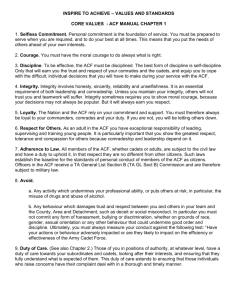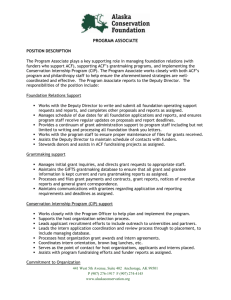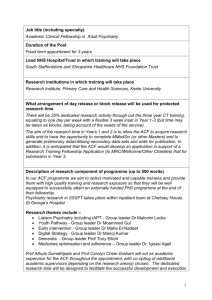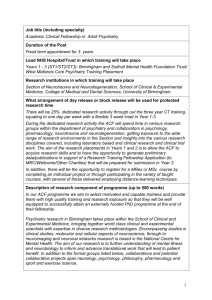Elementary Training in Emergency 3_3
advertisement
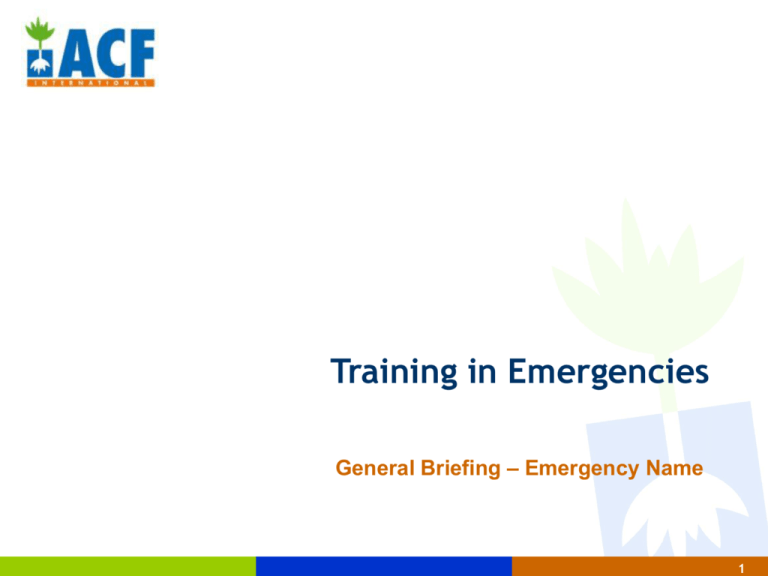
Training in Emergencies General Briefing – Emergency Name 1 Index Training Objectives What is ACF ? Organization chart Security management in the mission Driver responsibilities Communication Cash advances Stock management Quotations GPS 2 Training Objectives The objectives of this training is to explain to the staff recruited for emergency purpose the “basics operational procedure” of ACF. These slides can be used for assessment/ evaluation preparation (including all type of staff) and/or for specifics staff (logistician assistant – drivers…). To summarize: the idea is to popularize basic information in order to ensure the knowledge of ACF essential principles and guidelines by new staff. 3 What is ACF ? ACF is a humanitarian, professional Non Governmental Organization. It is private, apolitical, non-confessional and nonprofit making. Founded in 1979 Mandate: fight against hunger and malnutrition Intervention sectors: food security, watersanitation-hygiene, health and nutrition. Committed to the defence of the fundamental rights of distressed people. 4 ACF intervention sectors Nutrition and Health Save lives by lessening the risks of mortality linked to acute malnutrition. Prevent and treat infectious diseases, with primary health care in the framework of the fight against malnutrition. Food security Preserve, reinforce/restore the food selfsufficiency of vulnerable people. Water, Sanitation and Hygiene (WASH) Facilitate access to clean water and to the sanitary environment required for people’s survival and development. 5 6 Organization chart HOM ADMIN LOG WASH FS NUT Assist Admin Assist Log Assist Wash Assist FS Assist Nut Accountant.. Drivers, Packers, Guards Promoters Distributors, Monitors Nurses… 7 Security management in the mission – Why ? Objective of security rules: - Ensure the team members and the project will work in safe conditions. - Reduce the risks linked to the project implementation. - Risks: Medical problem, transport accident… Staff attack, material robbery… Animal bites… Conflictive area, collateral dammages.. OBJECTIVE OF SECURITY RULES = REDUCE/ BE PREPARED TO RISKS ABSOLUTE RESPECT OF THE RULES = COMPULSORY FOR EVERYONE SAFETY 8 Security in the mission – Standard Rules - Movement planning/ follow-up: Who is where and when ? Daily planning, managed from the base, 1 responsible. Everyday: movement planning for the next day - Communication: Communicate when arriving or leaving from 1 place (SMS). Communicate about situation in the area if necessary. 1 responsible per team. Always have phone contact list and/or constant companion - Time management: Respect the time schedules. Movements allowed by daylight exclusively. Inform of any delays or change of itinerary, explain the changes reasons. Compulsory daily phone report: 7:00am / 12:00noon / 7:00pm - 9 Security in the mission – Standard Rules Behaviour and visibility: - We represent ACF and its values: non religious, non political, independance. - We respect the country rules, and never bypass them - Always wear ACF ID card and ACF visibility Incident of any kind occurs: - Identify: nature of the incident, people involved, if incident is closed or still ongoing, what mitigations were taken - Report immediatly to the responsible 10 Security in the mission – Responsibilities Security Management is a responsibility shared by ALL team members. - Head of mission: Overall responsibility - Logistics coordinator: In charge of the teams follow-up, of the respect of the security rules… - Team responsible: In charge of the phone contacts, of communicating the possible itinerary changes… - Every team member: Individual responsibility (common sense) In case of evacuation: always respect an order: don’t discuss them on the moment, always after. 11 Transport – Driver responsabilities • - Load: Driver in charge of the ACF material safety transport (load-unload) No overload Always have relevant transport documentation (delivery note) • Vehicle: - In charge of the daily technical control of the vehicle + equipments - Always have necessary administrative documentation (insurance, driving licence, mission order…) - Ensure the First Aid Kit/ Emergency Trunk/ Water tanks/ Fuel Tanks are on board - Daily fill-up of fuel/itinerary follow-up documents (formats) 12 Transport – Driver responsibilities • - Passengers: Number of seats = number of passengers. Seat belt compulsory for all passengers. No passengers allowed in the load area. Passengers exclusively from ACF staff (no police, no military, no arms on board…) • - Speed: Speed adapted to context (village, asphalted…) Respect of the country rules Passengers must feel safe ! City/ villages: 50km/hour/ Main roads: 90km/hour 13 Communication • - Cellular Phone communication ACF will provide you with necessary credit load This credit is exclusively for ACF activities use Ensure your cell-phone always have minimal load to make one call/ send SMS in case of emergency. - Ensure your cell-phone battery is charged everyday. • - Satellite Phone communication Always 1 sat phone per team, with 1 responsible Daily check of the battery - daily report of use to Coordlog. Make sure always receiving signal (roof antenna) Always in hiding place, not to be seen by authorities Used in case of emergency or lack of regular cell-phone coverage 14 Communication Always be in a open area to make/ receive a sat-phone call ! Satellite Buildings Trees Sat-phone 15 Cash advances For purchases, transport… ACF provide cash advance to its staff. Your direct responsible must validate your cash advance. The cash advances are made by the administrator (you must specify the purpose of the advance) The cash advance is justified every day to the administrator, with invoices and/or receipts. 16 Cash advances What is a good invoice/receipt ? Original headed-paper from the provider (name, address, contact number, fiscal number…) Name of the purchaser: ACF-S/ ACF-S/ ACH Date of the purchase Detail of the purchased items (description + quantities) Total amount to be paid and currency Stamp from the supplier (legal or “paid”) 17 Good Invoice Example 18 Stock management Why do we need to follow-up the stock ? - To be reactive regarding the project implementation - To avoid loss and robbery Warehouse selection: Accessibility (cars and trucks…) Proximity to road infrastructure, port… Ventilation: dry and well ventilated place. Security: no broken window, door closing perfectly, roof in good state, flat and solid floor. - Maintenance: sane and easy to clean area. - 19 Stock management – Formats - Stock card: It’s the ID card of all the items we have in stock 1 stock card per type of item (oil 5 liters, rice bag…) 1 responsible for Stock Cards, allowed to update it. Stock Release Order (SRO): - It’s the authorisation to take something out from the stock - 1 SRO can allow the release of different items - 1 responsible for SRO = logistics coordinator 20 Stock management - STOCK CARD 21 Stock management – STOCK RELEASE ORDER 22 Stock management – Delivery note DELIVERY NOTE / BON DE LIVRAISON DN Reference / Référence BL : ________________________ Sender / Expéditeur Name / Nom : Adress / Addresse : Phone / Tél. : Signature : Date : _____________________ Consignee / Destinataire Name / Nom : Position : Adress / Addresse : Phone / Tél. : Transport mode / Mode de transport : Carrier / Transporteur Name / Nom : Adress / Addresse : Phone / Tél. : Registration N° / N° Immatriculation : Date : Signature : Procurement Request Line # Procurement Request # Requesting Dept Code Base Code Country Code Procurement Request Reference Référence Demande d'Achat Remarks / Remarques : 1: Sender / Expéditeur Description Quantity Quantité Unit Unité Quality, observations Qualité, observations Signature (Consignee / Destinataire) : Date & Name / Nom 2: Consignee / Destinataire 3: Sender (after update) / Expéditeur (après mise à jour) 23 Quotations We need quotations BEFORE making any kind of purchase ! What is a good quotation ? - Original headed-paper from the provider (name, adress, contact number, fiscal number…) - Name of the requester: ACF-S/ ACF-E/ ACH - Date – Validity of the quotation - Items description and quantities - Items unit price and total price with VAT - Items availability and/ or delivery time - Payment conditions - Signature and stamp from the supplier 24 25 Mission Country To: From: For : Quotations Date : Purchase Dossier Ref: OBJECT : When the provider can’t provide a formal quotation, we use the ACF quotation form: Quotation request for Item description Quantity Unit Remarks Additional specifications: - Payment conditions : - Payment after delivery inspection - Payment by bank transfer or cheque Delivery place and terms of transportation: - ACF office, located - Risks, insurance and cost related to the transportation of the items to the above mentioned address will be the responsibility of the supplier Minimum information to provide on the quotation 1 2 3 4 5 6 7 8 9 - Name, address, phone and contact person Characteristics of the items offered (to attach documentation if relevant) Quantity available Delivery time or Ex stock + location Unit price Total price Currency of the offer Validity of the quotation (Minimum 10 days) Date, stamp and signature. To submit an offer Response required before : Offer(s) to be sent under envelop to: Note: This quotation request is not an order and does not commit ACF on any obligation. 26 GPS – Points collection How works a GPS receiver ? • Minimum of 4 satellite signals to be received by the GPS unit to determine a position. • GPS units can determine your latitude, longitude and altitude. • GPS units DO NOT transmit satellite signals. They passively receive them. •They measure the distance between the GPS unit and the satellites 27 Garmin Etrex Introduction (1) Garmin Etrex GPS 28 Garmin Etrex Introduction (3) Garmin Etrex GPS 29 Garmin Etrex Introduction (4) Garmin Etrex GPS 30 Garmin Etrex Introduction (5) The page button allows you to enter the following: Satellite Page Map Page Navigation Page Trip Computer Main Menu 31 Garmin Etrex Introduction (6) SATELLITE PAGE: - Provides a visual of the satellites being tracked - Indicate which satellite signals are being received - The bars at the bottom show signal strength 32 Garmin Etrex Introduction (7) MAP PAGE: - Displays your movements, waypoints, latitude & longitude. - The black arrow shows your location - Press the Up & Down Buttons to zoom in and out on the map 33 COLLECT A GPS POINT BASIC STEPS TO COLLECT A POINT: 1- Select location 2- Activate GPS 3- Identify and mark location (“waypoint”) 4- Record location on form 34 1- Select the point collection location Find a place with a clear unobstructed view of the sky: • Geographic centre of the populated settlement area • Open area near the centre, or on top of a building in the centre • Hold the GPS unit flat and out away from your body 35 2- Activate the GPS receiver 2.1- Turn on GPS unit 2.2- Searching for satellites 2.3- Map Page 36 3- Mark location (1) 3.1- Mark location FROM THE MAIN MENU PAGE: - Use the PAGE button to go to MAIN MENU - Select MARK 37 3- Mark location (2) 3.2- Mark location FROM THE MAP PAGE: 38 3- Mark location (3) 39 3- Mark location (4) 40 4- Save location on form 41 4- Save location on form (2) Name of data collector: No Ex. Organization or Agency: Contact details: e-mail & phone Date Tehsil Union Council Latitude (North) Longitude (East) Elevation 24-nov-05 Bisham Ghaligai 34,8471 2 72,95493 5650' Type Name Description Helicopter landing zone Forward Area Support Site warehouse GPS Point Number 54 1 2 3 4 5 6 7 8 9 42
